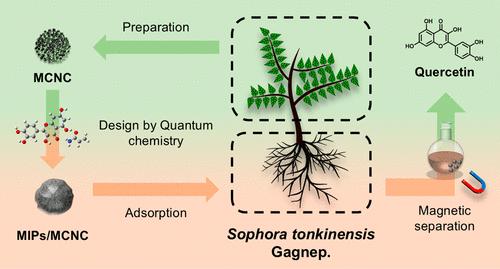山东苦参的闭环利用。用非药用部位的纳米纤维素制备磁性印迹聚合物,用于靶向槲皮素分离药用部位
IF 7.3
1区 化学
Q1 CHEMISTRY, MULTIDISCIPLINARY
引用次数: 0
摘要
重视生物质资源的利用是推进绿色化学和环境保护的重要一步,对减少碳排放和促进碳中和具有重要意义。将农业废弃物转化为生物质资源,如纳米纤维素,对低碳经济具有重要意义。此外,天然植物活性成分的环境友好和选择性分离仍然是需要解决的挑战。在本研究中,从“烧豆荚煮豌豆”的智慧中汲取灵感,对该草药(Sophora tonkinensis Gagnep.)的非药用部分的生物质进行处理,获得纳米纤维素,用于制备磁性分子印迹复合物,该复合物用于分离槲皮素和该草药的药用部分。以磁性Fe3O4纳米颗粒与纳米纤维素颗粒为载体,通过表面印迹法制备磁性纳米纤维素分子印迹聚合物(MIPs/MCNC)。对结构相似的柚皮素具有较强的吸附能力(Qe = 50.64 mg/g)、印迹因子(IF = 2.55)和特异性选择性(Ks′= 3.48)。经过5次吸附-洗脱循环后,再生能力保持在75%。该方法还成功地应用于复杂溶剂环境中,从深共晶溶剂(DES,氯化胆碱─丙烯酸)中选择性分离出槲皮素。此外,将跨学科方法整合到MIPs/MCNC的设计过程中,利用密度泛函理论(DFT)有效指导功能单体的设计。这项工作提出了一个具有重大潜力的概念,即将草药的非药用部分废弃物重新利用为纳米纤维素,并对有效成分进行环保和选择性分离。本文章由计算机程序翻译,如有差异,请以英文原文为准。

Closed-Loop Utilization of Sophora tonkinensis Gagnep.: Nanocellulose from Non-Medicinal Parts into Magnetic Imprinted Polymers for Targeted Quercetin Separation of Medicinal Parts
Emphasizing the use of biomass resources is a vital step in advancing green chemistry and environmental protection, significantly contributing to the reduction of carbon emissions and the promotion of carbon neutrality. Converting agricultural waste into biomass resources, such as nanocellulose, is of great significance for a low-carbon economy. Furthermore, the challenge of environmentally friendly and selective separation of natural active plant ingredients still needs to be addressed. In this study, drawing inspiration from the wisdom of “Pods burned to cook peas”, the biomass of the nonmedicinal portion of the herbal medicine (Sophora tonkinensis Gagnep.) was processed to obtain nanocellulose for the preparation of a magnetic molecularly imprinted composite, which was used to separate quercetin from the medicinal portion of this herbal medicine. The stacked complex of magnetic Fe3O4 nanoparticles and nanocellulose particles served as the carrier, and the magnetic nanocellulose molecularly imprinted polymer (MIPs/MCNC) was prepared through surface imprinting. It exhibited a strong adsorption capacity (Qe = 50.64 mg/g) and imprinting factor (IF = 2.55) as well as specific selectivity (Ks’ = 3.48) against structurally similar compounds (naringenin). The regeneration capability remained at 75% after 5 adsorption-elution cycles. It was also successfully applied in a complex solvent environment to selectively separate quercetin from the deep eutectic solvent (DES, choline chloride─acrylic acid) extract of S. tonkinensis Gagnep. Additionally, an interdisciplinary approach was integrated into the design process of MIPs/MCNC, utilizing density functional theory (DFT) to effectively guide the design of functional monomers. This work presented a concept with significant potential for reusing the nonmedicinal parts waste of herbal medicine as nanocellulose and for the environmentally friendly and selective separation of active components.
求助全文
通过发布文献求助,成功后即可免费获取论文全文。
去求助
来源期刊

ACS Sustainable Chemistry & Engineering
CHEMISTRY, MULTIDISCIPLINARY-ENGINEERING, CHEMICAL
CiteScore
13.80
自引率
4.80%
发文量
1470
审稿时长
1.7 months
期刊介绍:
ACS Sustainable Chemistry & Engineering is a prestigious weekly peer-reviewed scientific journal published by the American Chemical Society. Dedicated to advancing the principles of green chemistry and green engineering, it covers a wide array of research topics including green chemistry, green engineering, biomass, alternative energy, and life cycle assessment.
The journal welcomes submissions in various formats, including Letters, Articles, Features, and Perspectives (Reviews), that address the challenges of sustainability in the chemical enterprise and contribute to the advancement of sustainable practices. Join us in shaping the future of sustainable chemistry and engineering.
 求助内容:
求助内容: 应助结果提醒方式:
应助结果提醒方式:


